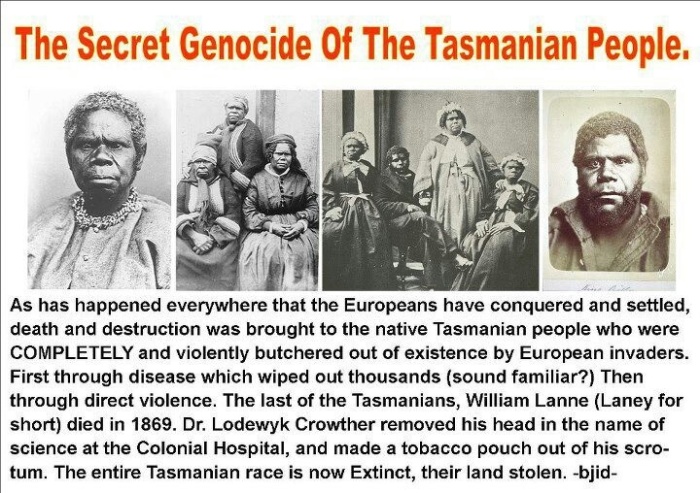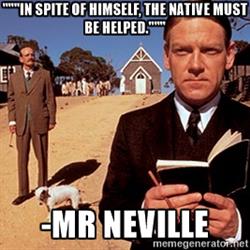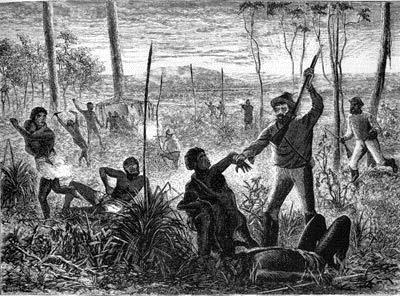By G.L.
The 1985 play by Aboriginal West Australian playwright Jack Davis, No Sugar, follows the Millamura family through their struggle against the white Australian government. The play became an international hit with its entry into the 1986 World Theatre Festival in Canada, highlighting the racial tensions and major discrimination of the Australian Indigenous, No Sugar gives a brutally truthful insight to the world or 1930’s Australia.
1. The “Tasmanian Solution”.

In Act One, Scene Seven, this exchange happens;
CONSTABLE: Should put a pinch of strychnine in the flour.
SERGEANT: Too late to adopt the Tasmanian solution.
For those of you who don’t know, the Indigenous people of Tasmania lived isolated from the world around them for tens-of-thousands of years on the small mountainous island 320km off Australia’s mainland. Then the European settlers came along, they found the more primitive group of just over 6000, and in the 18th century they decided to settle the island, using it as a form of ‘solitary confinement’ for convicts with serious crimes. There was an immediate negative reaction to this, as the white settlers would kidnap Tasmanian children for servants and women as concubines, the men were mutilated and killed for their hunting lands. In one case a lone shepherd killed 19 Tasmanians with a nail rifle [1] . Of course, the Tasmanian people retaliated, leading to Governor Arthur’s order that forced all Tasmanians to leave any area occupied by the whites, to enforce this order, “patrol teams” of prisoners led by policemen were set up to chase and kill any Tasmanians that disobeyed. Later there was even a monetary prize attached to the act, and it even became a business venture for public and private patrol teams.
Eventually the aforementioned poisoning of flour happened, along with hunting the Tasmanians and trapping them. When all of that didn’t prove ridiculously helpful, the remaining Tasmanians were ‘re-accommodated’ to Flinders Island, although many died on the boat ride there, with only 200 surviving.
By 1869 only three Tasmanian Aboriginal people remained.
Further Reading; http://combatgenocide.org/?page_id=146 1
http://splash.abc.net.au/home#!/media/2443619/impact-of-european-settlement-on-aboriginal-tasmanians
https://www.theguardian.com/world/2002/oct/14/australia.features11
2. How the “Protector of Aborigines” tried to breed out dark skin.

“Are we going to have one million blacks in the Commonwealth or are we going to merge them into our white community and eventually forget that there were any Aborigines in Australia?” – A.O Neville (1937).
Yeah, he actually said that.
Convinced he was actually helping the Indigenous people, Neville too makes an appearance in No Sugar, at first he seems like a well-meaning kind of guy, he treats his secretary, Miss Dunn pretty well (although a little sexist-ly), he’s quite patient and understanding with characters like Jimmy and the Sergeant. However he’s extremely condescending, such as in his letter to Mr Neal in Act One, Scene Two; “I’m a great believer that if you provide the native the basic accoutrements of civilisation you’re halfway to civilising him.”
However his more well-known line of action against the Aborigine population was the policy of “breeding out” dark skin, referenced directly in Act Three Scene Three. Neville’s big plan to assimilate the Aborigine people into white society was to “cross-breed” darker skinned Aborigines with light skinned Europeans, with the first generation of the cross known as “half-caste”, all the way down to the completely white skinned generation.
2. (½) Eugenics.
So, basically Neville’s idea is based around the theory and practice of Eugenics, which is defined as the following by http://www.dictionary.com/browse/eugenics :
noun, ( used with a singular verb)
- the study of or belief in the possibility of improving the qualities of the human species or a human population, especially by such means as discouraging reproduction by persons having genetic defects or presumed to have inheritable undesirable traits (negative eugenics)or encouraging reproduction by persons presumed to have inheritable desirable traits (positive eugenics)
And it is more thoroughly portrayed in the 2002 film Rabbit Proof Fence which follows the story of three Aboriginal girls stolen from their family in 1931 to be trained as house servants for white families. In this scene “Rabbit Proof Fence – Unwanted Third Race – YouTube”, Neville’s weird and virtually cruel thought process is shown, that by simply and almost systematically forcing together white and Aboriginal couples, the problem of biracial children would be removed.
Further Reading; http://www.sbs.com.au/ondemand/video/633217603607/ao-neville
https://collections.museumvictoria.com.au/items/1496210
3. “The native must be helped in spite of himself.”

In the 1930’s in WA the treatment of the Indigenous was only getting worse, with rationing turning draconian with the refusal of soap, yet the expectation that Aborigines be clean and regularly washing, and then the refusal of meat (also referenced in the text in Act One, Scene Two, and later again in Scene Seven). The overall policy on Aboriginal matters was essentially left to good old A.O Neville, and it was blatantly racist and virtually worked to contradict itself, forcing the assimilation of the Indigenous into white society, yet segregating them harshly, such as with the reservations such as the Moore River Settlement and Government Well. From all over the country, Aboriginal children were sent to the Moore River Settlement, to the point that disease from extreme overcrowding became the norm, with “grossly inadequate health and sanitary facilities” and escapes common. In No Sugar the settlement is the second home of the Millamura family, after they are forcibly taken from Government Well because of an “outbreak of scabies” (AKA a local election influenced by the Indigenous population of the region), and they aren’t treated too much better there. The whipping incident from Act Four, Scene Two was a common occurrence at the camp, with the flour that the girls were whipped over, still given to the inhabitants as a part of their rations. And it wasn’t completely uncommon for the white government officials and police officers stationed at settlements to sexually assault Aboriginal girls.
Further Reading; https://www.findandconnect.gov.au/guide/wa/WE00948
http://www.smh.com.au/news/western-australia/mooreriver/2005/02/17/1108500208308.html
4. The massacre of Indigenous people.

“During the first half of the 20th century the Aborigines were written out of Australian history. This had the convenient effect of hiding much of the domestic bloodshed, allowing the celebration of what came to be viewed as a uniquely peaceful history of settlement… For generations weaned on this soothing syrup the new history of the frontier came as an unwelcome revelation and one often stoutly resisted.”
~Henry Reynolds
The massacre mentioned in No Sugar is of the Oombulgari people, however it may just be a different name for the Oombulgurri Massacre of 1927, in which 11 Aboriginal people were massacred by the police, their bodies burned to hide the evidence. Two police officers were charged with one murder, but were acquitted anyways. The systematic killing of Indigenous people in Australia has been happening literally since the European settlers landed on red soil.
From the massacre of Botany Bay in 1790, to the Bathurst and Coniston massacres of the 1920’s, it has always been justified through the persecution of ‘criminal acts’ and the Bible or the protecting the safety of the Aborigines themselves.
Further Reading; https://www.findandconnect.gov.au/guide/wa/WE00077 http://www.smh.com.au/news/western-australia/mooreriver/2005/02/17/1108500208308.html
http://www.australianstogether.org.au/stories/detail/frontier-violence
5. “Government of Western Australia, Fisheries, Forestry, Wildlife and Aborigines.”

It may be hard to believe now, but not all that long ago, the government of Australia categorised Indigenous Australians as animals; fauna of Australia that were almost like an endangered species requiring protection. The Aborigines department makes its first appearance in Act One, Scene Two, and is the workplace as the previously mentioned (and totally helpful) A.O Neville, and his fairly polite secretary Miss Dunn. For the government department focussing on the ‘rights and fair treatment’ of the Aboriginal population, the GWAFFWA heavily stresses the segregation of dark skinned people, as shown by the “native’s entrance” which is out the back of the offices. Opposed to this, the character of Miss Dunn is quite polite and sympathetic towards Jimmy, rather than telling to use the “native’s entrance” she tells him that he can wait on the bench on the verandah out the back, and is generally very friendly. The treatment of the Indigenous Australians as animals (or next to) was a horrific manipulation of human rights, especially as the Indigenous population continues to experience the racist views of many white Australians today.
Further Reading; http://www.survivalinternational.org/news/98
Everything you have set out to do in this blog you have done.
You’ve clearly put a lot of effort into finding contextual information and you’ve provided readers with an overview of this as well as an opportunity to follow your hyperlinks and explore things in more detail.
I love the 1/2 in the title as it makes it stand out.
Great job!
LikeLike